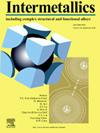低温气体渗碳对CoCrFeMnNi高熵合金力学和摩擦学性能的影响
IF 4.8
2区 材料科学
Q2 CHEMISTRY, PHYSICAL
引用次数: 0
摘要
本文研究了低温气体渗碳(LTGC)对CoCrFeMnNi高熵合金(HEA)的影响,重点研究了相关的组织演变,以及由此导致的力学和摩擦学性能的变化。结果表明,LTGC是一种有效的CoCrFeMnNi HEA表面强化处理。LTGC后,在合金表面形成~ 32 μm厚的渗碳层,具有高硬度(~ 12.8 GPa)和高残余压应力(~ 2.5 GPa)的特点。这种情况由膨胀的FCC相组成,它是FCC晶格中碳原子的无碳化物,过饱和的间隙固溶体。LTGC对CoCrFeMnNi HEA宏观拉伸性能的影响有限,导致CoCrFeMnNi HEA的极限拉伸强度有一定的提高,而屈服强度和延伸率有轻微的降低。同时,LTGC可以显著改善摩擦性能,将体积磨损率从11.4 × 10−4降低到0.45 × 10−4 mm3/Nm,将摩擦系数从0.51降低到0.49。此外,LTGC后的磨损机制从磨料、粘接、氧化和疲劳磨损的组合转变为主要由磨损和氧化控制的混合磨损机制。本文章由计算机程序翻译,如有差异,请以英文原文为准。
Effect of low-temperature gaseous carburization on mechanical and tribological properties of CoCrFeMnNi high-entropy alloy
This study investigated the effect of low-temperature gas carburization (LTGC) on CoCrFeMnNi high-entropy alloy (HEA), focusing on the associated microstructural evolution, as well as the resulting changes in mechanical and tribological properties. The findings demonstrate that LTGC is an effective surface strengthening treatment for CoCrFeMnNi HEA. After LTGC, a ∼32 μm thick carburized case forms on the alloy surface, characterized by high hardness (∼12.8 GPa) and high compressive residual stress (∼2.5 GPa). This case consists of an expanded FCC phase, which is a carbide-free, supersaturated interstitial solid solution of carbon atoms in the FCC lattice. LTGC exerts limited influence on the macroscopic tensile properties of CoCrFeMnNi HEA, it leads to a modest increase in ultimate tensile strength, with slight reductions in yield strength and elongation. While, LTGC can significantly improves the tribological performance, reducing the volumetric wear rate from 11.4 × 10−4 to 0.45 × 10−4 mm3/Nm and decreasing the coefficient of friction from 0.51 to 0.49. Additionally, the wear mechanism transitions from a combination of abrasive, adhesive, oxidative, and fatigue wear to a mixed wear mechanism primarily governed by abrasion and oxidation after LTGC.
求助全文
通过发布文献求助,成功后即可免费获取论文全文。
去求助
来源期刊

Intermetallics
工程技术-材料科学:综合
CiteScore
7.80
自引率
9.10%
发文量
291
审稿时长
37 days
期刊介绍:
This journal is a platform for publishing innovative research and overviews for advancing our understanding of the structure, property, and functionality of complex metallic alloys, including intermetallics, metallic glasses, and high entropy alloys.
The journal reports the science and engineering of metallic materials in the following aspects:
Theories and experiments which address the relationship between property and structure in all length scales.
Physical modeling and numerical simulations which provide a comprehensive understanding of experimental observations.
Stimulated methodologies to characterize the structure and chemistry of materials that correlate the properties.
Technological applications resulting from the understanding of property-structure relationship in materials.
Novel and cutting-edge results warranting rapid communication.
The journal also publishes special issues on selected topics and overviews by invitation only.
 求助内容:
求助内容: 应助结果提醒方式:
应助结果提醒方式:


